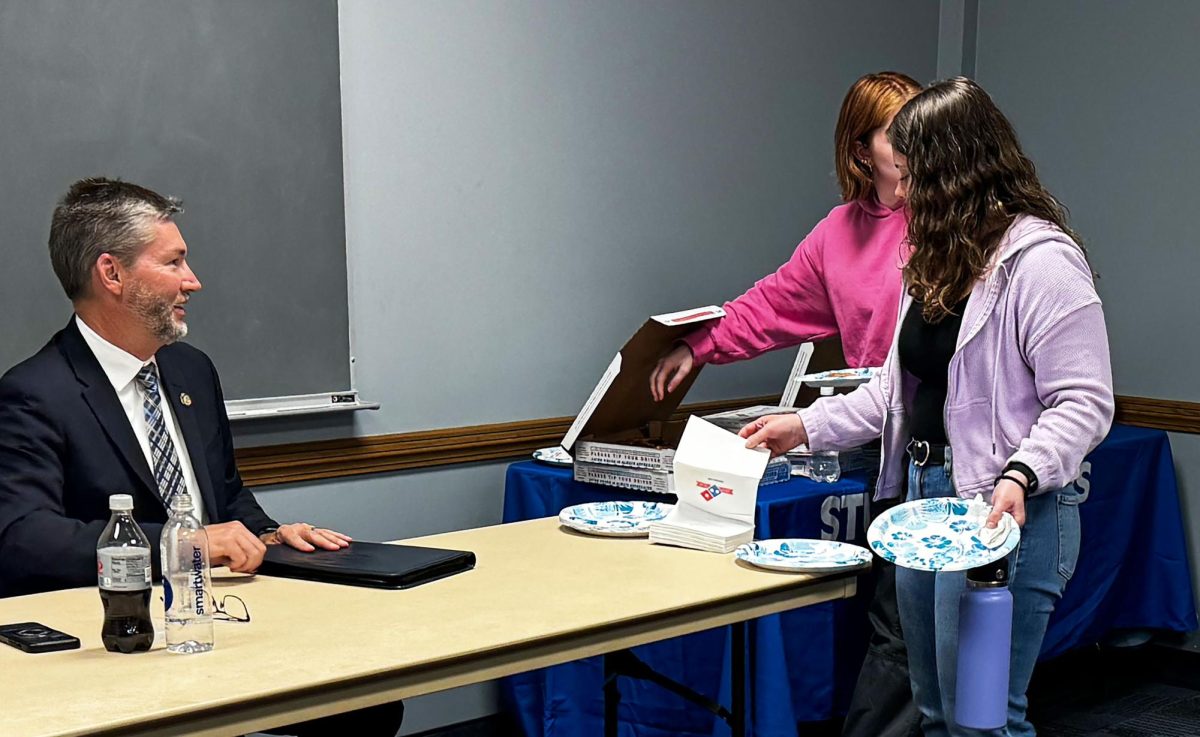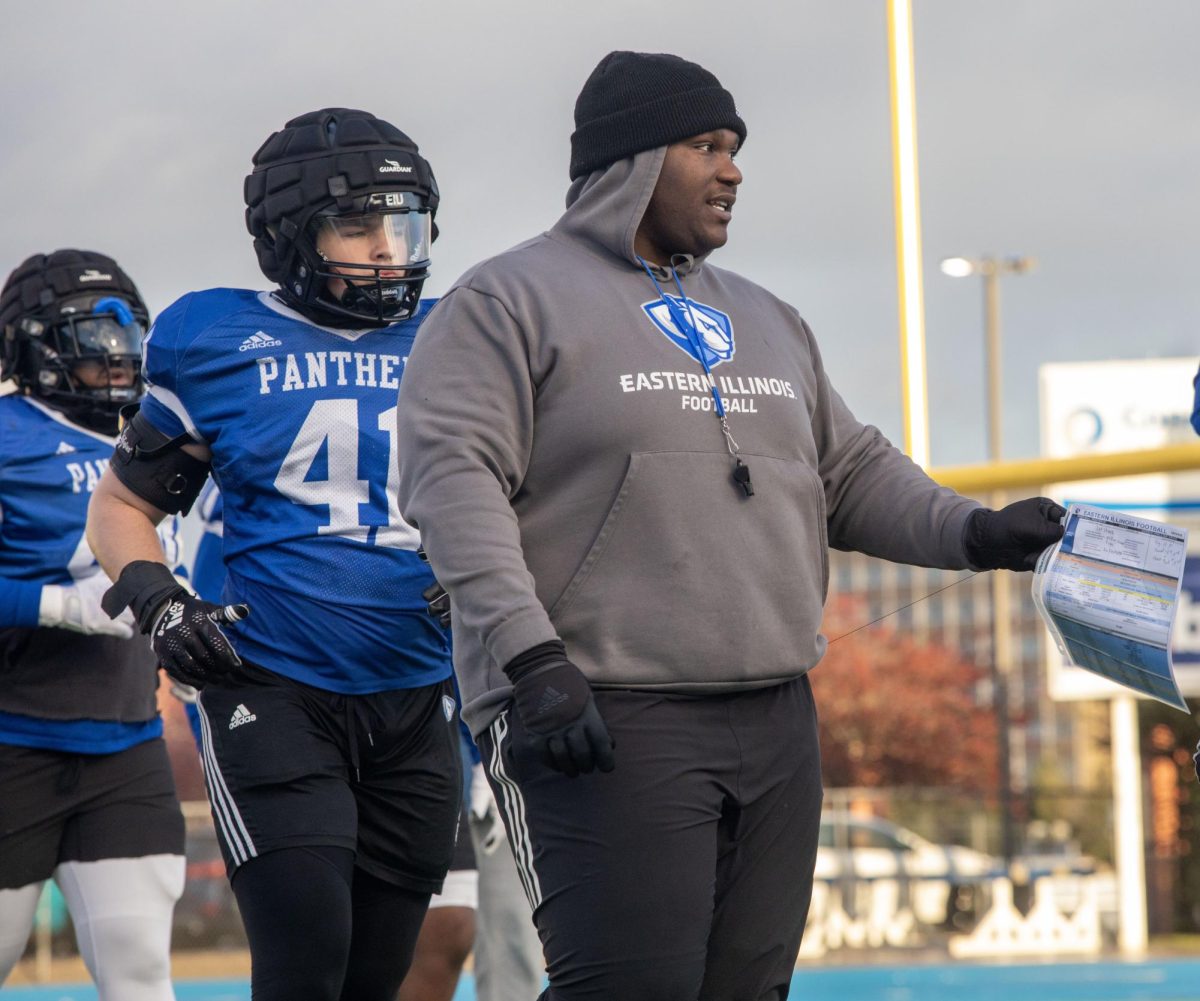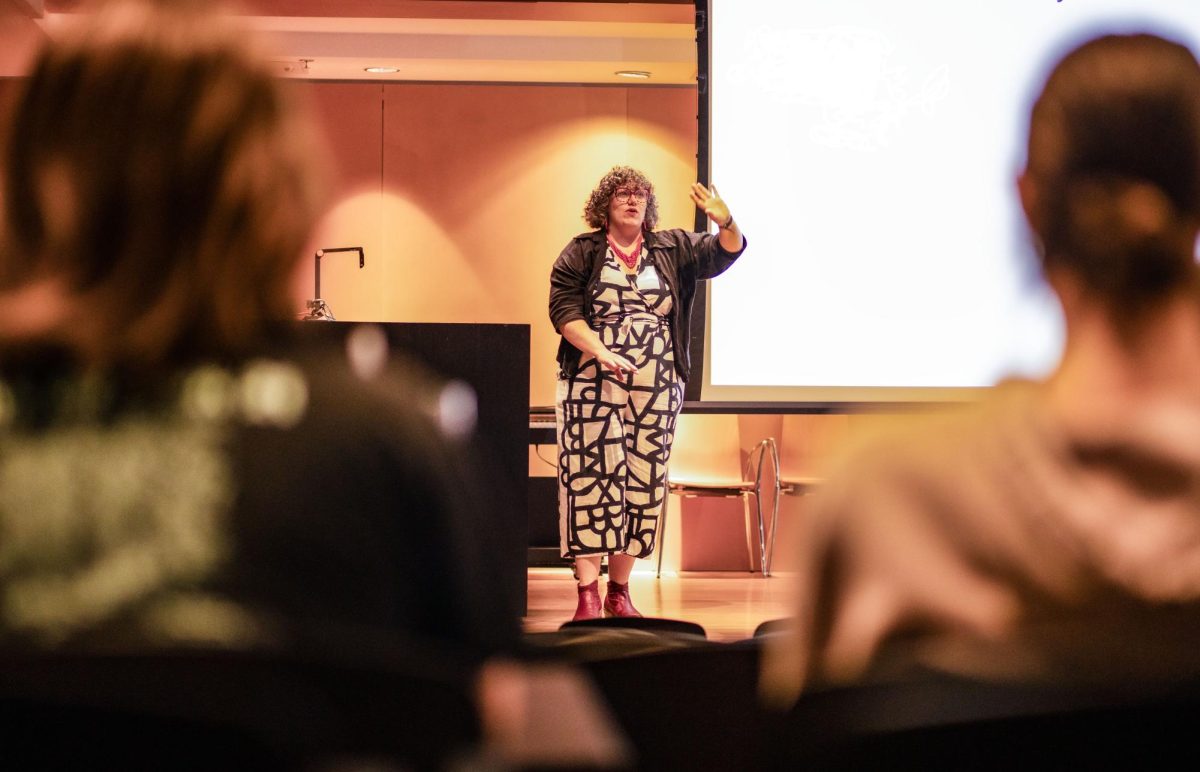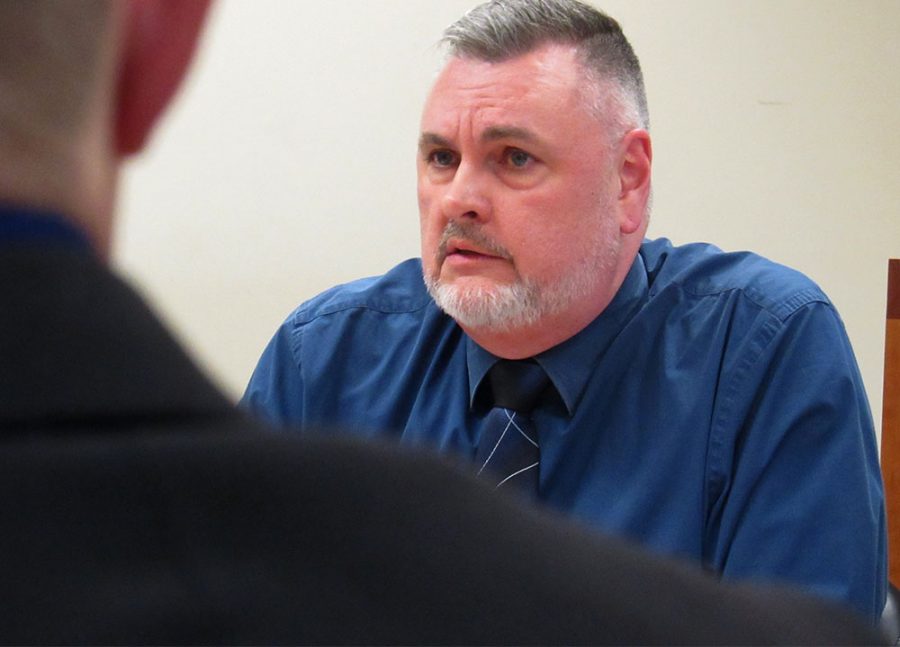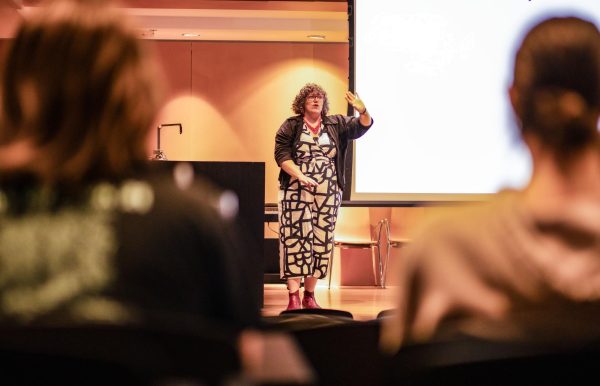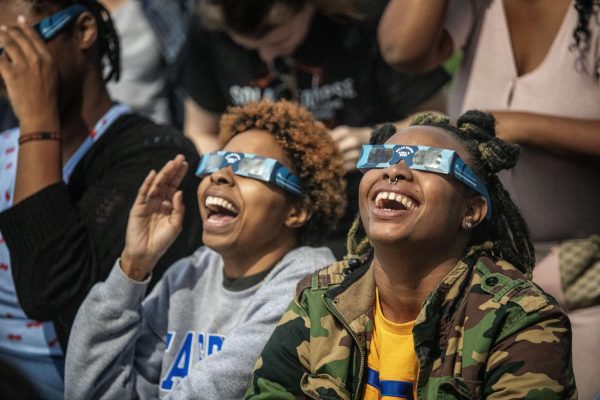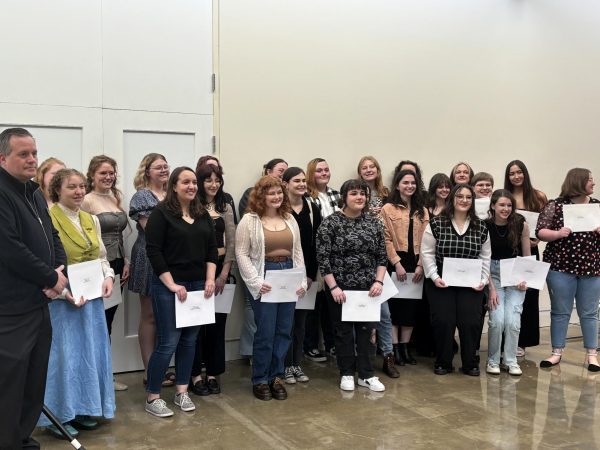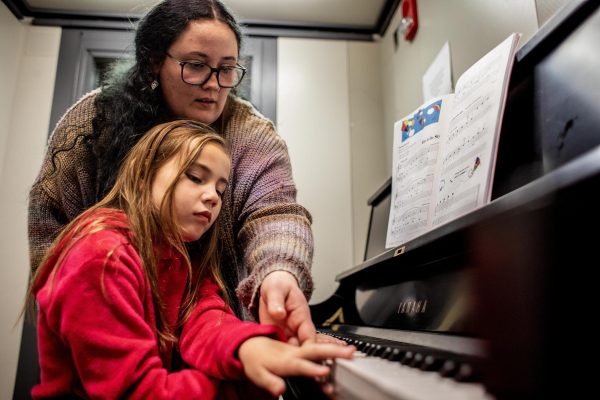Faculty Senate hears concerns regarding information technology centralization plan
Analicia Haynes | The Daily Eastern News
Todd Bruns, the Faculty Senate chair, speaks to members of the senate during a meeting Tuesday afternoon in Room 4400 of Booth Library.
January 8, 2019
Concerns regarding the integration of library technology services with Eastern’s information technology services were brought before the Faculty Senate Tuesday afternoon.
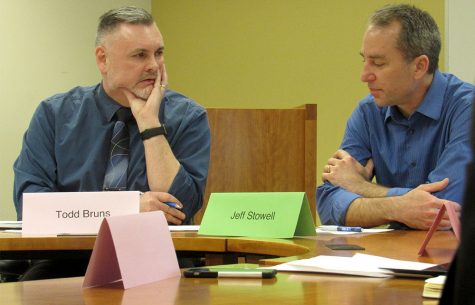
Todd Bruns, the Faculty Senate chair, talks with Jeffery Stowell, the Faculty Senate vice chair during a meeting Tuesday afternoon in room 4400 of Booth Library.
Stacey Knight-Davis, the head of library technology services, presented to the senate and said in Nov. 2018 she was informed that ITS plans to “take over all library technology infrastructure and control most of library systems in the summer of 2019.”
She said this new information technology centralization plan “to remove library systems from the library will leave a detrimental effect on on teaching and learning at Eastern” because “every aspect of library operations depends on library servers.”
And she said it is nearly impossible to retrieve or use library resources without utilizing library administered technology.
“The library’s online presence is made of multiple servers housed in the library, running a mix of open source software and locally developed scripts, that interconnect library systems and services at Eastern with systems and services provided by contracted information servicer providers,” she said.
The new information technology centralization plan was originally proposed by Workgroup No. 2 during the Vitalization Project.
According to the workgroup’s prioritized recommendations, it was deemed that the reorganization of the IT structure at Eastern was needed in order to prevent “duplication of effort” since the IT areas were setting similar types of services to fulfill directives assigned to it.
The workgroup said the old structure created a lack of standardization because each area (such as Library Services and ITS) catered to its specific needs.
As a result, the workgroup said this increases the overall cost to implement the technology and sometimes projects that were intended to help fulfill directives and projects are never completed “due to lack of funding, since no sustainable funding model for maintenance and support were put into place.”
Therefore it was recommended that in order to, “enhance efficiency and to maximize the productivity of limited resources, it is imperative that (the university) modify (the) organizational structure of IT on campus to enable a unified growth of technology in support of the overall mission of Eastern.”
Joshua Awalt, the interim assistant vice president for ITS, said in an email that the biggest step in carrying out this recommendation or plan happened July 1, the start of the fiscal year, when CATS was combined with ITS.
He said by the end of this year though that they want to continue this process by looking to integrate Library IT systems.
“The final phase would be to evaluate and determine how to proceed with integrating the IT staff and systems from the departments within Student Affairs,” Awalt said. “Optimistically, I would like to finish this centralization prior to the start of the next school year to reduce any type of disruption to our faculty, staff and students.”
Knight-Davis said she was “deeply concerned” regarding the lack of communication during the centralization plan development and said the library was exempt from the plan.
On page 19 of the Workgroup No. 2 final recommendations under section 3.3.3, it states the creation of a Central IT Committee that will serve the critical function of allowing all technology units on campus a channel to communicate their specific needs to the chief information officer.
On the same page it states that overall, “functions and services that are unique to a technology unit, such as Booth Library’s services and WEIU’s broadcasting needs, will remain the purview of the specific units because they will know the technology needs the best.”
Knight-Davis said she was not consulted at any point in the planning process and neither were any of the library faculty.
She said the plan devalues the library faculty, whom she said are trained professionals with the experience to administer library information services.
“I do not see how taking the administration and information services away from highly experienced, professional librarians could in any way enhance learning and research at (Eastern),” she said. “The plan does not recognize that faculty and student research and dissemination of faculty and student research depend on library technology infrastructure administered by librarians.”
However, Eastern’s Provost Jay Gatrell said, however, that this plan is still a “work in progress” and a final decision has not been made, rather a meeting held in December established “dialogue” to figure out the “scale of the scope” and make sure the “integrity of the library was maintained.”
“Someone should inform Mr. Awalt of that because his staff contacted me this morning saying they wanted to complete documentation by January so they can start with the migration,” Knight-Davis said in response to Gatrell’s comment.
Gatrell said he believes the process is not predetermined though there are some targets that relate to Workgroup No. 2 recommendations.
He also said Knight-Davis will maintain her permissions and leadership role in all things related to library programs and software.
What he said is changing revolves around the technical piece of having a backup for the servers and having a support team.
“How do we make sure we’re efficiently servicing computers and have access to backups for emergency or non-emergency situations,” Gatrell said.
Ultimately, he said the “grand plan” is that every server or system on campus be linked to ITS and every individual server have someone who is available as backup.
Knight-Davis said there is a clear lack of communication based on what she was being told by Awalt and ITS and what Gatrell said at the meeting.
She told Gatrell that what he said needs to be lined out in writing and ITS needs to “slow down.”
“We’re getting a lot of pressure,” she said.
Gatrell said when it comes to the question about the technology in the library and why there is a push to centralize the servers to ITS, there are limited resources and the university does not want to reinvest in a new server for the building.
“There are some technology issues with this building, there’s water intrusion and some other things that complicate our belief to have a clean room and things you need for a server environment,” Gatrell said, citing other reasons why the library does not have a new server.
Knight-Davis disagreed with Gatrell and said the room where the server is housed has a power backup system among other things, and she said there is no leak in that room.
“I get it, you don’t want to give us the money for the server,” Knight-Davis said. “What concerns me is every other unit I see work with ITS it’s a slow nibbling removal of control and when the initial conversation is, ‘We’re going to take full control,’ it makes me quite nervous.”
But Gatrell said ITS is different than what it was a year ago, even though the concerns Knight-Davis described happened a month ago.
Awalt could not be reached for further comment, but he will be at the next Faculty Senate meeting.
More information will be added to the story as soon as it becomes available.
Analicia Haynes can be reached at 581-2812 or [email protected].




